Fuel consumption represents a major expense item over the year at around 30% of total expenses, but you can reduce this amount simply by adopting good habits.
Fuel consumption is very different from one farm to another and can be linked to many different factors such as the type of activity, the size of the farm, how far away the fields are, the type of soil, the weather conditions… and also different habits as regards the use of agricultural equipment such as speed on the road, implement settings, the choice of crop farming methods and tyre management… This last point is among the most important, because the tyre has an impact on consumption at every level. It has a direct impact on your fuel consumption in addition to an indirect impact linked to the presence of the tyre for all the other parameters and all user practices.
In this article we look at how good tyre management can help you save a lot of money on fuel.
There are obviously many factors behind the increase in fuel consumption, which varies depending on several parameters, i.e.:
- Your farm layout, size of fields, distance between fields and farm.
- The type of soil (clay, silt…).
- The weather conditions and moisture content.
- The choice of crop farming methods (deep tilling…).
- The initial tractor power.
- The working speed and engine RPM.
- The driving behaviour (type of driving).
- Implement maintenance and settings.
- Type of tyre and tyre settings.
The tyre is linked directly or indirectly to each of these points
This is why it is important to optimise the choice of tyres, tyre settings and regular inflation pressure management. This will procure a non-negligible and cumulative effect on fuel consumption if you include other factors such as a change in cropping system or adopting eco-driving techniques by reducing speed or engine RPM wherever possible.
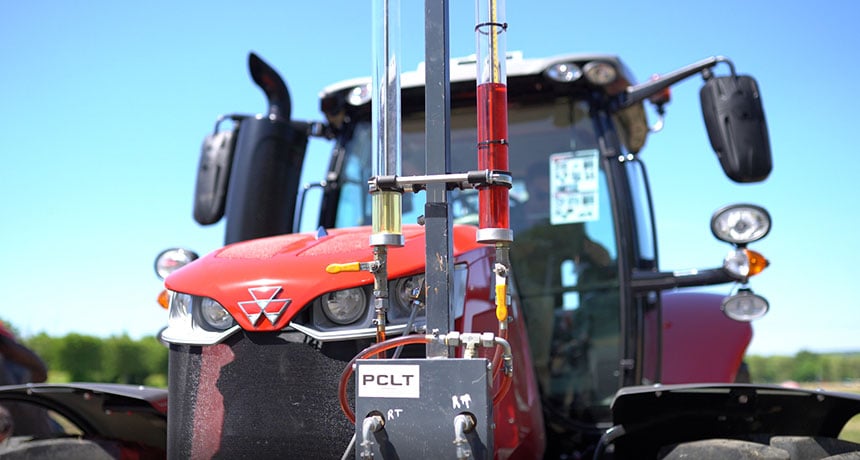 External fuel gauge for verification during fuel consumption tests
External fuel gauge for verification during fuel consumption tests
Here is how your tyres impact your fuel consumption and what you can do to reduce it to make major savings throughout the year:
1. How does rolling resistance increase your consumption?
When you work in the fields, your tractor must produce the tractive force necessary to pull your implements. This is closely linked to the quality of the connection between the ground and your tyres. This tractive force corresponds to the force that your tractor has to produce to enable the tyres to move forwards.
Rolling resistance will depend on the quantity of earth in front of the tyre which the tyre must get past in order to continue moving forwards.
Rolling resistance increases:
- if the ground is soft,
- if the weather conditions are bad,
- if your implements are heavy or
- if your tyres are overinflated.
Your tyre then sinks further into the ground, increasing the quantity of earth which the tyre needs to get past. This means that more tractive force is required for your tractor to travel forwards (without taking into account the earth which may accumulate in front of the trailed implement).
If rolling resistance is low, you need less power to make the tyres move forwards. Inversely, too much rolling resistance inevitably results in more fuel consumption, because the engine will overrev to enable the tyres to move forward.
When you work in the fields, rolling resistance must be reduced as much as possible to avoid sinking into the earth. The choice of tyre is therefore crucial to increase the tractor’s bearing capacity. Suitable tyres with a large soil footprint must be chosen. This makes it possible to spread the weight of your trailer over a larger contact patch with the ground and maintain the tyre on the surface of the soil. By increasing the size of the soil footprint you will reduce fuel consumption while providing your tractor with optimal traction.
2. Why reduce pressure in the fields?
Poor inflation pressure management has a negative impact on your fuel consumption. We effectively often make the mistake of overinflating tyres for work in the fields to compensate for the weight of the implement. Increasing the inflation pressure in the tyres leads to excessive slippage and soil compaction, particularly when the soil is wet or soft.
In the fields, an overinflated tyre has a smaller soil footprint and therefore less grip. The lugs do not have a large enough contact patch with the ground to provide good traction and the rigidity of an overinflated tyre reduces its flexibility and consequently its self-cleaning capacity. Earth accumulates between the lugs, which increases the risk of excess slippage, above all in wet conditions.
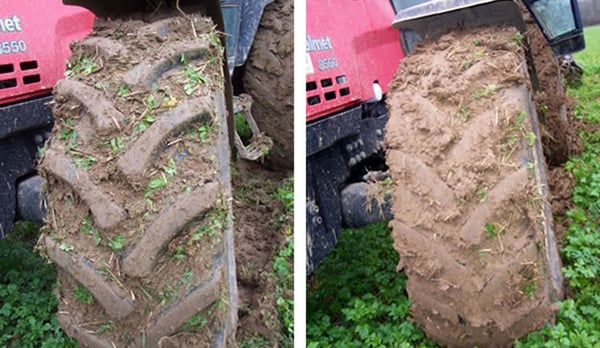 Change in tyre pressure test in the same field
Change in tyre pressure test in the same field
on the left 1 bar = no slip,
on the right 1.25 bar = excessive slip.
To compensate for these phenomena and obtain around 10% in fuel savings, you should opt for low pressure of between 0.6 and 1.3 bar, depending on the weight of your implements and your tyre technology.
3. Why to opt for better weight distribution
Heavy work in the fields such as tilling leads to high fuel consumption. However, you can minimise this fuel consumption by avoiding too much load transfer to the rear axle, linked to the weight of the implement, together with a shift of weight from the front axle.
Excess weight on the rear axle frequently increases slippage and fuel consumption. By distributing the weight more evenly by means of suitable front ballasting, so as to balance out the load and obtain 40% of the weight at the front and 60% at the rear, you will obtain a better use of the front and rear axles. All the tyres will work together in the tractive effort, thus requiring less engine power.
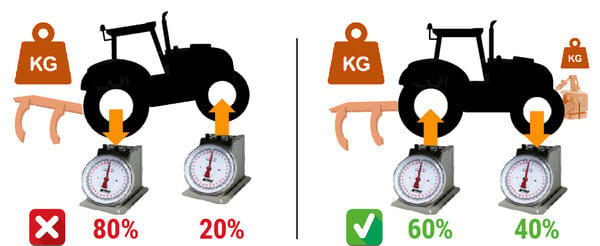 Good weight distribution on my tractor tyres
Good weight distribution on my tractor tyres
Careful use of a front implement, in addition to the rear implement, can help obtain the right weight distribution. You will work more efficiently, with less trips back and forth, thus reducing fuel consumption.
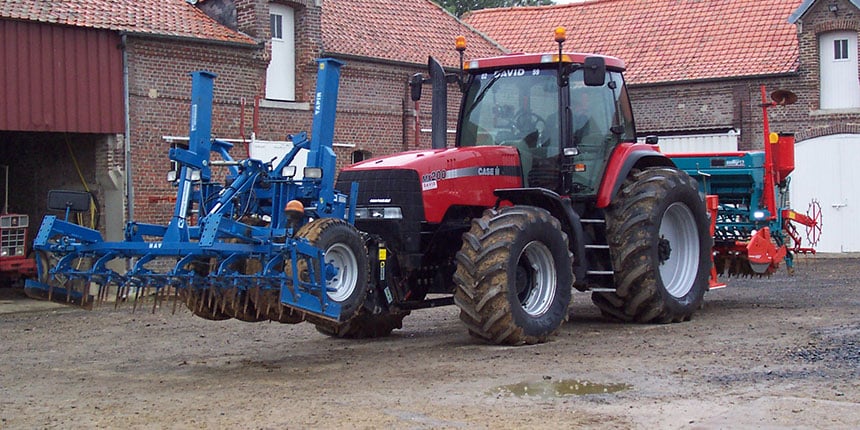 Weight distribution using a front implement to compensate for the weight at the rear
Weight distribution using a front implement to compensate for the weight at the rear
By increasing the load on opposite axles depending on which implement you are using, you can optimise your tractor’s grip on the ground.
The better the traction, the less slippage there will be. Good weight distribution is therefore an excellent way of reducing fuel consumption while making the most of your tractor’s tractive force without wastage.
By reducing slip, you reduce fuel consumption by around 10%.
4. Why increase pressure on the road?
When you travel between your fields and your farm, you may have a long distance to cover on the road.
Unlike earth, asphalt does not compact, whatever the weight of your trailer. Only your tyres adapt, by crushing down onto the road surface, depending on the weight that they carry. The bigger the contact patch between your tyres and the asphalt, the more your rolling resistance increases. On the road, speed plays a decisive role in fuel consumption, especially if your tyres are underinflated.
By driving at speed with a low inflation pressure, you will increase fuel consumption, because the engine will have to work harder to make your tractor move forwards.
By reducing speed by 10 km/h on average with slightly overinflated tyres, you can make huge fuel savings over a full year.
On a road surface, unlike in the fields, the more you increase the pressure, the smaller the contact patch with the ground, leading to less rolling resistance. By overinflating your tyres slightly (+0.5 bar), you will improve the stability of your tractor while reducing wear and fuel consumption.
5. Increase the tyre size
Among the different solutions which make it possible to reduce your fuel consumption, increasing the size of your wheels is a very interesting option for a field crop farmer.
Larger tyres effectively enable a better distribution of pressure and traction capacity over a larger contact patch with the ground. For this you have to increase the tyre’s section width by opting for a model from series 75, 70, 65 or even 60. This will make it possible to reduce the extent to which the tyre sinks into soft ground thanks to the wider soil footprint and the increased contact patch with the ground.
Increasing the tyre series improves the traction capacity of your tyres and reduces slip. By combining correct inflation pressure and the right tyre size you can reduce fuel consumption by around 30%.
Before changing your tyres, make sure that the new dimensions are adapted to the following parameters:
- The tractor power
- The drive ratio
- The overall dimensions of the tractor
GOOD TO KNOW: If you opt for tyres with a high volume of air, this can be done by reducing the diameter of the rims. This way you can keep the initial developments without placing any further mechanical strain on your tractor. Increasing the volume of air with large size tyres allows you to increase load, as it is the volume of air linked to the pressure contained within the tyre which makes it possible to bear the load.
6. Choose low-pressure IF tyres
There are now tyre designs on the market that are more high-tech than standard tyres, which allow you to reduce fuel consumption while avoiding soil compaction, such as FIRESTONE’s maxi traction IF tyres.
These allow you to increase the load by 20% compared to standard tyres and limit lost time, because you no longer have to get out of the cab to change inflation pressure between fields and road.
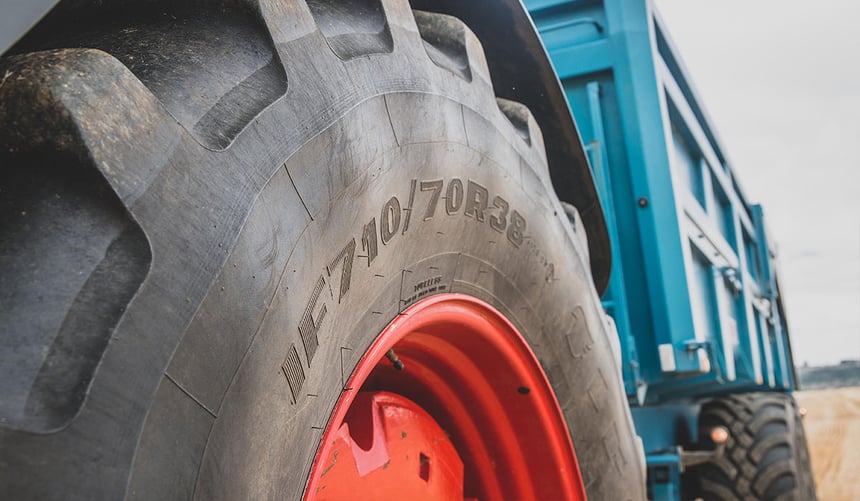 Firestone’s Maxi Traction IF tyres
Firestone’s Maxi Traction IF tyres
Thanks to a more robust design and supple, resistant sidewalls, these new generation agricultural tyres offer you the possibility of working at low pressure (0.8 bar), without taking account of the type of soil (soft, wet…).
IF agricultural tyres reduce rolling resistance, and as such your fuel consumption, which allows you to improve overall productivity.
They have a large soil footprint for a better distribution of the weight of the tractor, thus reducing soil compaction following repeated trips over the land in your fields.
To find out more and extend the lifespan of your tractor tyres, download our free comprehensive guide: “How to adjust the pressure in my tractor tyres to gain hours more use”.
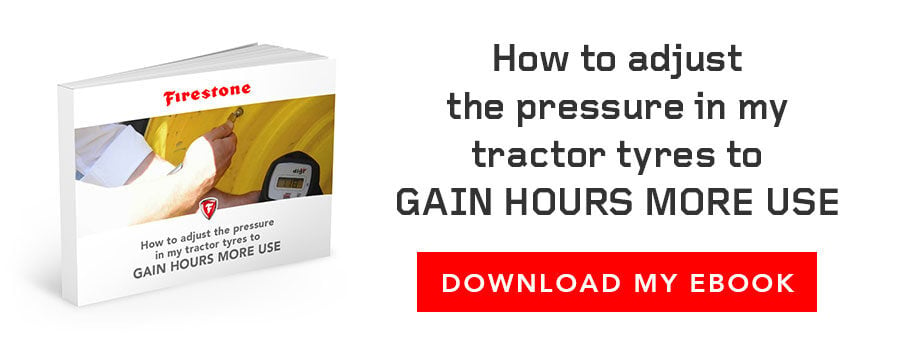
Most people who read this article have also read some of the following articles:
This information is intended only to make you aware of the technical and functional aspects of agricultural tires and their use. It does not allow you to make a judgment or a definitive conclusion on a given problem. Only your agricultural tire expert is able to make a technical assessment and take a final decision, case by case.